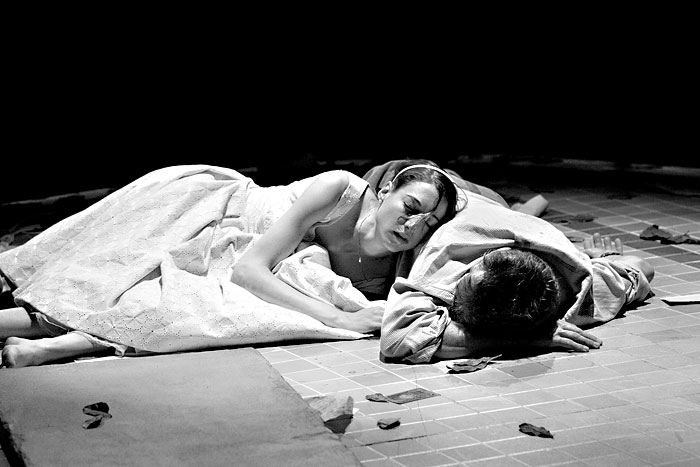PICK Eurydice
ACT Theatre, 700 Union St., 292-7676, www.acttheatre.org. $10–$55. Tues.-Sun. at various times. Ends Oct. 5.
Let’s say you’re looking for a memorable night on the town with your pals e.e. cummings, Sylvia Plath, and Jim Morrison. You could scarcely do better than to grab your trusty flask of absinthe and meet them all at ACT for a night of rumination on the romance of death that is Eurydice.
What does it mean to die? What will we miss, and who will mourn our passing when we’re gone? What existence awaits us on the other side? What would we do if given a chance to climb from the tomb and take up our lives again? Worthwhile questions all, asked with style and a languid grace by director Allison Narver in her rendering of the classic Greek tragedy.
In this retelling by New York playwright Sarah Ruhl (The Clean House), the emphasis rests squarely on Eurydice, the star-crossed wife of Orpheus, rather than on her grieving husband who journeys to the underworld to plead for her return through music melancholy enough to make stones weep. It’s as much meditation as play, with Narver making the most of her cast and set designer Matthew Smucker’s eerie end-of-summer dreamscape.
Smucker’s dilapidated swimming pool (complete with a prodigious diving board looming above) nods both to Carl Jung’s notions of water-as-unconscious and to the bygone innocence of those ’50s romances popularized by Sandra Dee and Troy Donahue. In fact, a still photo from any of Eurydice‘s early scenes would have made a fine cover for a pulp novel from the era.
Narver leavens the tragedy with humor and absurdity wherever possible. Her direction creates an entrancing undertow that ebbs and flows like a fevered reverie. Ensemble is critical in sustaining such a mood, and here the performers are uniformly and blessedly in sync. Renata Friedman—who appeared just weeks ago in the one-woman play The K of D—creates a Eurydice who hits just the right notes of terror and wonder opposite Trick Danneker’s lovesick preppy Orpheus. Mark Chamberlindigs deep into the inner conflict of Eurydice’s dead father, who first comforts his daughter in the underworld, then agonizes over relinquishing her to the living world.
While Eurydice expends most of its 90 minutes grappling with death and inconsolability, it’s never maudlin or mawkish. There’s a zippy rendition of the Andrews Sisters’ “Don’t Sit Under the Apple Tree (With Anyone Else but Me)” by the newlyweds; a gilded art-deco elevator is brought into play; and the ingenious sound design (concocted by Chris Walker) transforms the abandoned swimming pool into a Stygian catacomb with the pluck of a few lyre strings. There’s even some clever business for the Greek chorus of stones who chide each new arrival to accept death and eternal silence. Is their greasepaint meant to suggest kabuki? Is one of them lampooning Tallulah Bankhead? Is another suggesting Humpty Dumpty? No matter. It’s captivating.
Paul Morgan Stetler is the catalyst and mythological trickster in both worlds, doing for the role what Joel Grey did for the emcee in Cabaret. His work is mischief bordering on malevolence; in short, it’s brilliant. His ever-shrinking Little Lord Fauntleroy outfit serves as a reminder that this is not life, but a look at life from a murk much deeper than six feet under. As trouble personified, his creation is the stuff that wakes us up from a troubled sleep vowing never again to chase oysters Rockefeller with butterscotch ice cream. Like the rest of Eurydice, it’s haunting, provocative, and a nudge to wring the most from each moment spent above ground. Now pass the absinthe. KEVIN PHINNEY
PICK Project Orpheus
ACT Theatre, 700 Union St., 292-7676, www.seattledanceproject.org. $25. 8 p.m. Fri.–Sat. Ends Oct. 4.
The devil might not wear Prada in Seattle Dance Project’s newest work, but he does show up in a nice business suit. Project Orpheus is a spirited gloss on the classic tragedy, a frequently tongue-in-cheek retelling of a usually anguished story about loss and second chances. The fundamental elements of the myth are all there, but we see them through trifocal lenses.
No simple companion piece to ACT’s production of Eurydice (above), Project Orpheus employs three different choreographers who divide the story between them.
Modern-dance choreographer Eva Stone first puts Hades in a suit and the Furies in sleazy cabaret attire. Timothy Lynch makes for a grim G. Gordon Liddy–style figure as he passes his hand through the flame of his cigarette lighter, running the underworld like a Fortune 500 corporation. Betsy Cooper, Alexandra Dickson, and Kory Perigo are his oily minions, whose grabbing hands and snaky arms only mesh when they find a victim.
Next, Wade Madsen takes the biggest risk by introducing Julie Tobiason and Joseph Anderson in a disco setting. In the original myth, Orpheus could tame wild beasts with the beauty of his music; the analogue here is for him to be as smooth and sure on the dance floor as Tony Manero in Saturday Night Fever. Tobiason is endearingly naive as Eurydice, entering like Maria in West Side Story. Madsen literally stops the world when the two lovers meet, only here it’s an inconveniently timed cell-phone call that sets the tragedy in motion. (Presumably echoing Madsen’s own experiences as an artist, he stages the subsequent confrontation between Orpheus and Hades as a panel interview for a grant application; Orpheus has to audition to get into hell!)
Lastly, using a ballet vernacular, Olivier Wevers returns the tale to its basic themes. Orpheus’ journey to hell and back is emotional as well as physical—hopeful in one direction, forlorn on the way out. There are echoes of other productions in the lovers’ twining duet in the underworld, with Eurydice wrapping herself around Orpheus as he struggles not to look backward. Later, in Wevers’ use of the floor during Orpheus’ two “weeping” solos, grief literally presses our hero to the ground. SANDRA KURTZ




